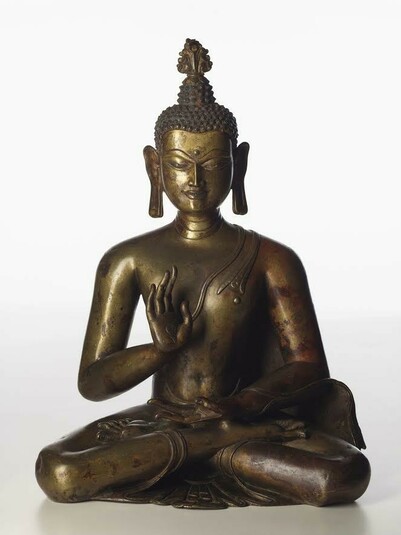
Item: Amoghasiddhi Buddha - Buddha
| Origin Location | Tibet |
|---|---|
| Date Range | 1100 - 1199 |
| Lineages | Buddhist |
| Material | Metal |
| Collection | Private |
Classification: Deity
Appearance: Buddha
Gender: Male
Amoghasiddhi, Buddha (Tibetan: don yo dru pa, sang gye): the patriarch of the fifth of the Five Families of Transcendent, or Symbolic, Buddhas. This figure is most probably part of a five figure set of sculpture depicting the Five Symbolic Buddhas.
Amoghasiddhi is associated with Vajrayana Buddhism and originates in the Tantric Literature of the Yoga and Anuttarayoga Tantra classes. The sculptural images generally fall into two groups, either as Buddhas with monastic robes and without ornaments known as nirmanakaya appearance or Buddhas in Bodhisattva Appearance with crowns and ornaments and known as sambhogakaya appearance.
The majority or paintings depicting Amoghasiddhi are predominantly understood within the context of dozens or hundreds of surrounding figures. These compositions belong to painting sets of five or more compositions that depict all of the deities described in the mandalas of the Vairochana, Tattvasamgraha or Sarvadurgati Parishodhana Tantras of the Charya and Yoga classifications of Tantric literature.
The Yoga Tantras were popularized in Tibet by Rinchen Zangpo in the 11th century and have been maintained up to the present day primarily in the Sakya and Sakya related traditions such as Shalu, Gyantse and Jonang. In general the Charya and Yoga Tantras fell out of popularity in the 14th and 15th century and gave way primarily to the texts and rituals classified as Anuttarayoga of the Sarma Schools and the 'Revealed Treasure' Traditions of the Nyingma Schools.
Jeff Watt 2-2014
Collection: Christie's, Jan. 28, 2014
Sculpture: Monastic Period (Tibet, 13-14th century)
Sculpture: Monastic Period (Nirmanakaya Buddha)
Buddhist Deity: Amoghasiddhi Buddha Main Page
Subject: Buddha Figures (Flaming Ushnisha)
